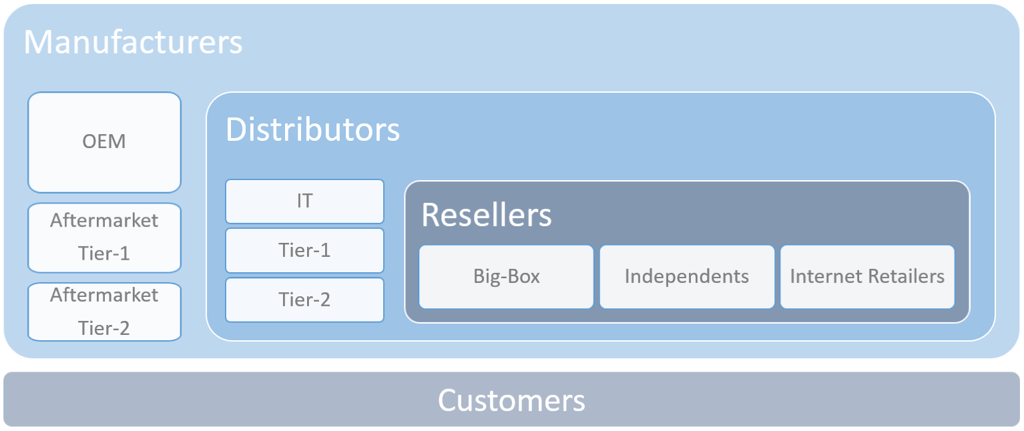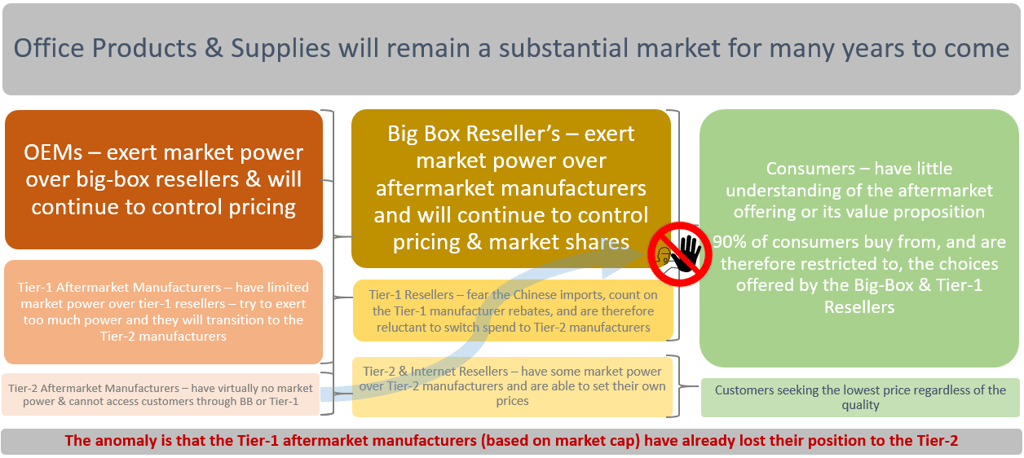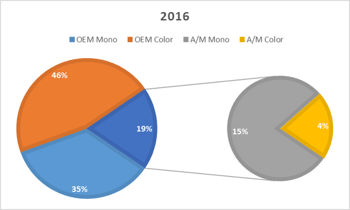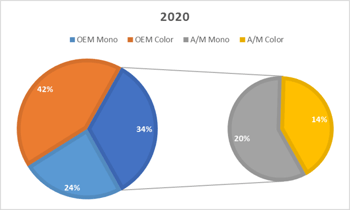With the emergence of the Chinese aftermarket ink and toner manufacturing superpowers, I anticipate new market share battles between the OEM and aftermarket brands. In this, the seventh part of the current series of blogs, I will explore where these battles will most likely occur. In previous posts in this series, I've explained the aftermarket tipping point and studied scenarios for the OEM and aftermarket manufacturer merger endgames, the reseller merger endgame, and the consumer adoption curve related to aftermarket ink and toner. The scene is now set to explore possibilities for market share development.
The Aftermarket, Office Supplies, and a Major Tipping Point Series
The Aftermarket Manufacturer'sEndgame (Part III)
The Reseller's Endgame (Part IV)
Summary - The Mergers Endgame (Part V)
The Consumer Product Adoption Stages (Part VI)
Below is a graph illustrating how office products get to market in North America. I already explained (in Part VI) how the OOEMs leverage their power over the distribution channels and effectively control market share between the original and aftermarket products.

Now look at the second graphic below illustrating how 90% of consumers buying office products choose to do so from the Big-Box and Tier-1 resellers and, consequently, only have access to the products offered by the OOEM'sand Tier-1 aftermarket manufacturers. Remember also my explanation in Part VI regarding how they OOEM'scontrol their market pricing and market shares through the rebate programs and other carefully deployed aftermarket blocking tactics.
There's a way for the Tier-2 [Chinese] aftermarket manufacturers to access the 90% of consumers who currently choose to purchase through the Big-Box and Tier-1 resellers because these resellers elect not to place the Tier-2 products into distribution for their customers to select from.
The OOEM's big-box and Tier-1 resellers have effectively organized themselves (or been organized) into a cartel, and there's no way for market shares to change unless this cartel arrangement is substantially breached.

Note my comment at the foot of the graphic that the small group which makes up what II'vetermed " the Tier-1 aftermarket manufacturers" (Clover Imaging Group, LMI Solutions, and Turbon) have, in fact, already effectively lost their Tier-1 status to the emerging Chinese superpowers. The Chinese aftermarket manufacturers have cost, capital, and product (new-build) advantages and, over time, have the power to breach the cartel that currently controls pricing and market shares.
Here are four scenarios that could potentially develop from these circumstances:
1. The OOEM'seliminate the Chinese threat
They OOEM'sindeed recognize the emergence of the Chinese superpowers and the threat they pose to their business model. Of course, they want things to remain as they currently are, with an ongoing and steady decline of the aftermarket share due to shrink in the monochrome market and their continued success preventing the aftermarket from breaking into the color market.
How better to achieve this and neutralize the Chinese threat in the process than by encouraging the big-box and Tier-1 resellers to transition from their current suppliers (Clover and Turbon) over to the Chinese? Remember, the OOEM'scontrol both pricing and market shares and, so long as the existing cartel structure is preserved, they can ensure there will be no change to the pricing model or the overall trend in market shares.
In this scenario, the cartel could be preserved, and the Chinese neutralized simply by encouraging the Tier-1 rreseller'sto replace their current suppliers. In doing so, tthey'llprobably get lower prices than they currently do from Clover, LMI, and Turbon, increasing their already substantial margins on aftermarket products in the process.
Don't forget they OOEM'scould also choose to buy compatibles directly from the Chinese to support their MPS contracts, just like tthey'vealready done with Clover and LMI. In doing so, tthey'dfurther neutralize the Chinese and make it less likely they'd go down a path to support resellers outside the cartel and attempt to build market share at the expense of the OOEMs
Development of this scenario would provide a significant boost to market share for the Chinese and a substantial loss to the current suppliers. However, so far as the OOEM'sare concerned, iit'sjust a pocket shift, and overall, they could achieve their goal of keeping things as they are. The cartel would be preserved - just one group of members would be changed from the incumbents to a new group of [Chinese] members.
Of course, Clover, LMI, and Turbon aren't going to roll over and let this happen without a fight. They provide many services to the big-box resellers and Tier-1 dealers that the Chinese would struggle to replicate, so it would be a disruptive change requiring significant adjustments by the resellers to try and make it work. Perhaps they OOEM'sincrease their rebates by a point or two for a few months to help pay for the transition - who knows?
Scenario Conclusion:
The OOEM'sare clever, very clever. They know how to play this game, so don't be surprised if some variation of this scenario plays out. Furthermore, it's not like they must do all or nothing - they may start with small, seemingly innocuous moves that we may not even hear about and then more aggressively when necessary. I rate the chances of the OOEM'splaying a leading role in the Chinese increasing their share at the expense of the existing players at a modest 2 out of 5.

2. Amazon figures out the B2B Channel
All the aftermarket manufacturers (Chinese and domestic) are already selling directly and indirectly on Amazon. So far, only a relatively small segment of consumers (mainly B2C) have chosen to buy their ink and toner cartridges from this channel.
What if Amazon decides to step deeper into the fray? We know they'd like more of the action in the office products vertical - we don't know how much they want it!
We know tthey'vecaptured consumers (mainly B2C) of office products through their marketplace, and we know they have a decent understanding of the market. We know they'd like the B2B business, and they've-vamped their Business Service Division to try and win more of this business.
We also know Walmart is making a big push into e-commerce, and we've recently heard analysts speculating about the potential advantages they may develop over Amazon if they're able to leverage their 5,000 stores as distribution and pick-up centers - just as Best Buy has been successfully doing over the last couple of years.
What if Amazon also views WWalmart'sstrategies as a potential threat and decides to snap up OfficeDepot to counter them? Not only a massive step up for them in terms of the B2B contract stationery business but also 1,400 retail locations that could counter potential advantages Walmart may be able to develop. Furthermore, what could Amazon stock in those Office Depot retail locations besides office products in the future?
Scenario Conclusion:
Amazon has a lot going on, and it would be enormously risky for them to take on a brick-and-mortar retailer such as Office Depot and integrate it into its existing business. Furthermore, even if they did, then to improve the overall Office Depot business model, tthey'dface the same issues I'm going to explain in the following "reak-rank" scenario. Why would Amazon contemplate buying OfficeDepot if the constraints to improve its business model (i.e., aftermarket cartridges) put the business it had acquired at risk? Overall, I rate this scenario's chances at a slim 0.5 out of 5.

3. A Big-Box Retailer breaks ranks
After the Staples deal to acquire OfficeDepot failed, Depot came out of the mess with all guns firing. They appear to have a plan and are taking decisive action. Their CEO, Roland Smith, declared on May 16th, 2016, when the deal finally collapsed, that the ccompany'sfuture would depend on "old new action."
What if they decided to take bold new action, unilaterally exited the cartel, and gave more prominence to aftermarket cartridges? Remember, the gross margins on OEM sales (after factoring in rebates) are 10-15%, whereas they're 65%+ on aftermarket cartridges - potentially even more if they were sourced directly from the Chinese.
| OEM | Aftermarket | Total | Future | Change | |
| Sales | $3,800M | $250M | $4,050M | $1,580M | -$2,470M |
| GM % | 10% | 65% | 12.5% | 65% | +52.5% |
| GM $ | $380M | $162.5M | $542.5M | $1,027M | +$484.5M |
Let's assume Office Depot has $3.8 billion in OEM cartridge sales at 10 points of gross margin and $250 million in aftermarket cartridge sales and decided to exit OEM and only offer aftermarket.
Let's assume that action resulted in a loss of 50%, or $1.9 billion, of their existing OEM cartridge business. Then, the remaining $1.9 billion was discounted by 30% (per the aftermarket model), so it became $1.33 billion. However, this $1.33 billion is at 65 margin points, not 10 points.
As shown in the table - that's a new total of just over $1 billion margin dollars, a pick-up of nearly $500MM!
Of course, this is an extreme scenario with many implications beyond the risk of losing nearly $2.0 billion in cartridge sales. This strategy would put customer (not just product) retention at serious risk. If ink and toner are 40% of a typical ccustomer'sspend on office products, then a $2.0 billion loss in cartridge sales would likely compromise $5.0 billion in overall customer sales. That's putting 40% of their North American top line at risk!
Scenario Conclusion:
As the management at OfficeDepot may look at the attractive margins on aftermarket ink and toner, and they may want to take bold steps forward, I don't see a successful transition path to the scenario II'vedescribed. So, this is not a viable path for breaking the cartel and increasing aftermarket share. Unfortunately, Depot is trapped inside the existing cartel arrangement, so I have to rate the likelihood of this path developing as zero out of five.

4. Tier 2 & 3 Resellers emerge, empowered by the Chinese
The OOEM'sddon'thave much influence over the strategies and tactics of the Tier-2 distributors and the smaller independent office product resellers. Because they don't have much power, this group may represent a potential future threat to the OOEM, particularly if they combine with the newly emerged Chinese aftermarket manufacturing superpowers. This possibility must be worrisome for the OOEM'sand may account for specific actions, like HHP'smassive shake-up of its authorized reseller program between 2012 and 2014. This strategy may have been targeted explicitly toward weakening a category of resellers they could not control and that (when sufficiently weakened) they did not believe had strong prospects for competing successfully with them in the future. In other words, despite their actions leading to intense levels meant within a large group of resellers, they did not believe this action was gowouldback and bite them in the future!
Think for a moment about SSGT'sacquisition of the global Cartridge World franchise. There are 500 franchise locations throughout North America and a similar number scattered in other international markets. This acquisition is a prime example of a Chinese superpower acquiring distribution to bypass the cartel. This franchise is not focused on the dog-eat-dog world of internet-related bottom-feed pricing. This franchise focuses on quality, its brand I, and cal presence in major local markets. This is a franchise focused on the "blue ocean" of OEM conversions, not the " ed ocean" of random internet business with high customer churn and razor-thin margins.
Think briefly about OOfficeDepot's" tore of the future" strategy - this isn't so different from the Cartridge World concept. A smaller physical presence in local markets with the ability to leverage relationships and minimize customer churn by continuing to deliver a first-class customer experience.
Think for a moment about BestBuy. Everyone was predicting they didn't have a future; tthey'dbecome a showroom where you could touch and feel products you were interested in before leaving to go and find the best deal online. Who would have thought BestBuy could successfully adapt and now show promising signs of winning such a significant battle against Amazon and other online retailers? What does this developing success story tell us about customers wanting to deal with someone instead of something physically? The internet has not eliminated the human desire to interact with real people!
What could all this mean for the smaller independent resellers and their future in the office products and supplies space?
Firstly, the focus on the " ed ocean" of random e-commerce initiatives should be curtailed, and there must be a new emphasis on doing what OfficeDepot, Staples, Tier-1 independent dealers, and a franchise like Cartridge World are doing. These organizations all appear to believe a solid physical presence in local markets is essential to their future business prospects. The Tier-2 dealers need to adopt a similar approach.
It should not be beyond their means to do so. Firstly, they have ready and willing partners to select from regarding the Chinese superpower manufacturers. Secondly, the Tier-2 distributors of these Chinese products have the import and the logistics expertise to get products quickly and economically to the rreseller'scustomers. In being prepared to leverage these products and capabilities alongside an upgrade of their unique technology platforms, there's the possibility to have a meaningful impact in the medium to longer term. However, to succeed with this approach will mean developing sufficient trust and confidence in their capabilities necessary to satisfy the performance requirements of the "blue ocean" caliber customers currently served by the Tier-1 retailers and resellers.
Scenario Conclusion:
The development of a sales channel outside of the existing cartel has already started and its future success is likely. For me, the big question is not whether or not this development will succeed; it's more about the scale of its success. If we assume there are 5,000 independent Tier-2 and three resellers left in the United States and Canada, and that (for example) Cartridge World makes up 500, or 10% of this number. Will it be just 10% recognizing the opportunity to empower themselves for success, or 25% or more? Just imagine 1,500 resellers leveraging technology to transform their businesses; imagine if they each had an average of $1 million in annual sales - that adds up to $1.5 billion in aggregate. That's a potentially important sales channel development story that would keep the OOEM'sawake at night!
Because of the existing cartel's strength and ability to block the growth of the aftermarket, I believe further development of this independent sales channel, tthat'soutside the cartel's control, is the only viable path to achieving increased aftermarket share. I rate its longer-term likelihood of success at a robust 4 out of 5!

Conclusions:
The critical point to understand is that wwe'reentering a new phase in the development of the office products vertical, so change is likely, and, as always, there will be winners and losers. For those that are prepared, change will bring opportunity.
For the smaller, local resellers that focus on their value proposition, including developing their ability to compete effectively with the service routinely provided by larger companies, there will be opportunities to benefit their businesses. However, instead, they choose to get caught in an online price game with poor quality, potentially infringing products, or inadequate information technology systems. They'll be poorly positioned and will fail to benefit at all.
The aftermarket products are well positioned from a technology, cost, and competitive standpoint. Remember, for example, unlike the OOEM, the aftermarket value chain ddoesn'thave to give up any margin dollars subsidizing hardware development or distribution costs.
The biggest potential losers (if the smaller resellers are motivated to step up) stand as the OOEM'sand the big-box retailers. A move from 20% to 35% aftermarket share represents an annual shift of over $3.5 billion in retail dollars. We know a change of this scale cannot occur through the cartel, and if it takes place at all, then only the independents can make it so.


